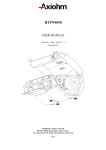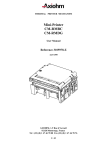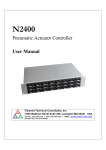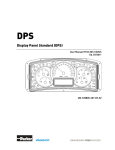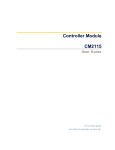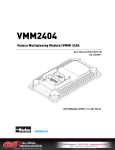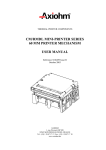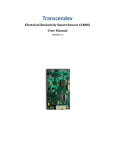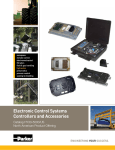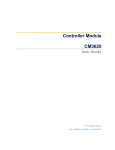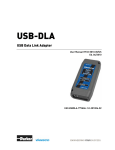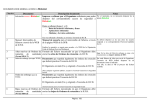Download True Ground Speed Sensor (TGSS) 740
Transcript
TGSS True Ground Speed Sensor (TGSS) 740 User Manual HY33-5005-IB/US Ed. 01/2012 UM-TGSS-740000-00-201201-03 Parker Hannifin Corporation Electronic Controls Division 1305 Clarence Avenue Winnipeg, MB R3T 1T4 Canada Office +1 204 452 6776 Fax +1 204 478 1749 http://www.parker.com/ecd http://www.vansco.ca http://www.iqan.com Copyright 2012 © Parker Hannifin Corporation. All rights reserved. No part of this work may be reproduced, published, or distributed in any form or by any means (electronically, mechanically, photocopying, recording, or otherwise), or stored in a database retrieval system, without the prior written permission of Parker Hannifin Corporation in each instance. Warning! FAILURE OR IMPROPER SELECTION OR IMPROPER USE OF THE PRODUCTS AND/OR SYSTEMS DESCRIBED HEREIN OR RELATED ITEMS CAN CAUSE DEATH, PERSONAL INJURY AND PROPERTY DAMAGE. • This document and other information from Parker Hannifin Corporation, its subsidiaries and authorized distributors provide product and/or system options for further investigation by users having technical expertise. • The user, through its own analysis and testing, is solely responsible for making the final selection of the system and components and assuring that all performance, endurance, maintenance, safety and warning requirements of the application are met. The user must analyze all aspects of the application, follow applicable industry standards, and follow the information concerning the product in the current product catalog and in any other materials provided from Parker or its subsidiaries or authorized distributors. • To the extent that Parker or its subsidiaries or authorized distributors provide component or system options based upon data or specifications provided by the user, the user is responsible for determining that such data and specifications are suitable and sufficient for all applications and reasonably foreseeable uses of the components or systems. Offer of Sale The items described in this document are hereby offered for sale by Parker Hannifin Corporation, its subsidiaries or its authorized distributors. This offer and its acceptance are governed by the provisions stated in the "Offer of Sale" elsewhere in this document, or available at www.parker.com. Contents Contents 1. Introduction 1.1. Safety symbols 2. Precautions 2.1. 4 4 5 General safety regulations 5 2.1.1. 2.1.2. 2.1.3. 2.1.4. 6 6 6 6 Construction regulations Safety during installation Safety during start-up Safety during maintenance and fault diagnosis 3. Product Description 7 3.1. TGSS 7 3.2. Compliances 8 4. Installation 9 4.1. Installation Guidelines 4.2. 4.1.1. Mounting Bracket 4.1.2. Mounting Angle 4.1.3. Mounting the TGSS to a vehicle 4.1.4. Line of sight clearance 4.1.5. Installation Validation Performance Considerations 5. Technical Specifications 9 9 10 11 11 12 13 14 5.1. Microwave Output 14 5.2. Speed Output Signal 14 5.3. Radar-Present Output 14 5.4. Connectors 15 6. Electrical Specifications 16 7. Environmental Specifications 17 8. Mechanical Specifications 18 8.1. Dimensions 9. Appendix A 9.1. 18 19 TGSS Technical Overview 19 9.1.1. 19 Environmental ratings 10. Index True Ground Speed Sensor (TGSS) 740 23 3 Introduction 1. Introduction These instructions are meant as a reference tool for the vehicle manufacturer's design, production, and service personnel. The user of this manual should have basic knowledge in the handling of electronic equipment. 1.1. Safety symbols Sections regarding safety, marked with a symbol in the left margin, must be read and understood by everyone using the system, carrying out service work or making changes to hardware and software. The different safety levels used in this manual are defined below. WARNING Sections marked with a warning symbol in the left margin, indicate that a hazardous situation exists. If precautions are not taken, this could result in death, serious injury or major property damage. CAUTION Sections marked with a caution symbol in the left margin, indicate that a potentially hazardous situation exists. If precautions are not taken, this could result in minor injury or property damage. NOTICE Sections marked with a notice symbol in the left margin, indicate there is important information about the product. Ignoring this could result in damage to the product. Contact the manufacturer if there is anything you are not sure about or if you have any questions regarding the product and its handling or maintenance. The term "manufacturer" refers to Parker Hannifin Corporation. True Ground Speed Sensor (TGSS) 740 4 Precautions 2. Precautions 2.1. General safety regulations Work on the hydraulics control electronics may only be carried out by trained personnel who are well-acquainted with the control system, the machine and its safety regulations. WARNING Mounting, modification, repair and maintenance must be carried out in accordance with the manufacturer's regulations. The manufacturer has no responsibility for any accidents caused by incorrectly mounted or incorrectly maintained equipment. The manufacturer does not assume any responsibility for the system being incorrectly applied, or the system being programmed in a manner that jeopardizes safety. WARNING Damaged product may not be used. If the control system shows error functions or if electronic modules, cabling or connectors are damaged, the system shall not be used. WARNING Electronic control systems in an inappropriate installation and in combination with strong electromagnetic interference fields can, in extreme cases, cause an unintentional change of speed of the output function. NOTICE As much as possible of the welding work on the chassis should be done before the installation of the system. If welding has to be done afterwards, the electrical connections on the system must be disconnected from other equipment. The negative cable must always be disconnected from the battery before disconnecting the positive cable. The ground wire of the welder shall be positioned as close as possible to the place of the welding. The cables on the welding unit shall never be placed near the electrical wires of the control system. True Ground Speed Sensor (TGSS) 740 5 Precautions 2.1.1. Construction regulations CAUTION The vehicle must be equipped with an emergency stop which disconnects the supply voltage to the control system's electrical units. The emergency stop must be easily accessible to the operator. The machine must be built if possible, so that the supply voltage to the control system's electrical units is disconnected when the operator leaves the operator’s station. 2.1.2. Safety during installation CAUTION Incorrectly positioned or mounted cabling can be influenced by radio signals which can interfere with the functions of the system. 2.1.3. Safety during start-up WARNING The machine's engine must not be started before the control system is mounted and its electrical functions have been verified. Ensure that no one is in front, behind or nearby the machine when first starting up the machine. Follow the instructions for function control in the Start-up section. 2.1.4. Safety during maintenance and fault diagnosis CAUTION Ensure that the following requirements are fulfilled before any work is carried out on the hydraulics control electronics. • The machine cannot start moving. • Functions are positioned safely. • The machine is turned off. • The hydraulic system is relieved from any pressure. • Supply voltage to the control electronics is disconnected. True Ground Speed Sensor (TGSS) 740 6 Product Description 3. Product Description 3.1. TGSS The true ground speed sensor (TGSS) uses the principle of Doppler shift to determine the ground speed of the vehicle or other type of equipment. A microwave signal that is transmitted out of the sensor, reflects off the target and is received by the sensor. When the target (terrain) is moving relative to the sensor, there is a change in the frequency of the reflected signal (Doppler shift). The ground speed is calculated by measuring the change in frequency. The TGSS is enclosed in a black plastic case, which is potted to cover the electronics. The TGSS has a short cable terminated with a connector. Figure 1: TGSS with Deutsch DT04-4P connector Custom units with different cable lengths and connector types may be configured for OEM customers. Contact your Parker Vansco representative. True Ground Speed Sensor (TGSS) 740 7 Product Description 3.2. Compliances This device complies with RSS 210 of Industry Canada. Operation is subject to the following two conditions: (1) this device may not cause interference, and (2) this device must accept any interference, including interference that may cause undesired operation of this device. "Ce dispositif se conforme à la norme CNR-210 d'Industrie Canada. Les conditions suivantes s'appliquent à l'utilisation du dispositif: (1) le dispositif ne doit pas causer d'interférence radioélectrique, et (2) le dispositif doit être en mesure d'accepter toute interférence radioélectrique, même si celle-ci est susceptible de compromettre son fonctionnement." FCC ID: MGR740030A This device complies with Part 15 of the FCC rules. Operation is subject to the following two conditions: (1) this device may not cause harmful interference, and (2) this device must accept any interference received, including interference that may cause undesired operation. NOTICE Any changes or modifications not expressly approved by the party responsible for compliance could void the user's authority to operate the equipment. True Ground Speed Sensor (TGSS) 740 8 Installation 4. Installation The TGSS is typically installed at a height of 0.3 to 1 meter (1 to 3 feet) above the ground. The maximum height of installation is 1.22 meters (4 feet). The sensor mounts to a bracket on the underside of the vehicle where the sensor may be directed in either the forward or reverse direction. 35° Figure 2: Typical installation 4.1. Installation Guidelines The TGSS 740 Radar measures motion relative to itself. It is important to prevent unwanted motion in order to achieve optimal performance. The unwanted motion could be of the TGSS unit, or of an object within the radar's line of sight. 4.1.1. Mounting Bracket The bracket should be at least 6.35 mm (¼”) steel and the length kept short to minimize vibration. MIN. THICKNESS 6.35 [.250”] Figure 3: Mounting plate The bracket dimensions that follow can be used as a guideline for the desired bracket size. If it is necessary to increase the dimensions, consideration should be True Ground Speed Sensor (TGSS) 740 9 Installation given to increase the material thickness as well. This will help reduce the bracket's susceptibility to vibration. 178 [7.0] 178 [7.0] 267 [10.5] MIN IN 6,35 [.250] 35.0° 5X R 6,35 [.250] Figure 4: Recommended mounting plate dimensions The TGSS has rubber shock absorber vibration mounts to reduce the effect of machine vibration. The vibration mounts have an internal M6 thread, the recommended installation torque is 5.4-7.3 Nm (48-65 in lbs). Mounting Angle 6.6 [.26] Any error in the mounting angle will directly affect the Doppler accuracy. At 35°, an error of 1° is approximately a 1% error in speed measurement. Post installation calibration should be done to remove errors due to bracket alignment tolerances and vehicle levelness. 45.7 [1.80] MOUNTING PLATE 71.9 [2.83] 4.1.2. BEAM PATTERN 90° 35° GROUND LEVEL Figure 5: Installation angle True Ground Speed Sensor (TGSS) 740 10 Installation 4.1.3. Mounting the TGSS to a vehicle It is up to the original equipment manufacturer (OEM) to ensure the product is securely mounted to the vehicle. The following guidelines are related to physically attaching the TGSS to the mounting bracket on a vehicle: • The TGSS should be secured with bolts in all 3 bolt holes using 6 mm Hex Head bolts and locking washers. The bolts should be tightened to 5.4-7.3 Nm (48-65 in lbs). Appropriate length bolts are routed from the underside of the unit through the mounting plate and tightened into the shock absorbers on the unit's base. The bolts should engage the threads in the shock absorbers to a maximum depth of 6.35 mm (¼"). 4.1.4. Line of sight clearance It is important for the sight line of the radar beam to be as unobstructed as possible. Interference with radar beam can lead to false or erratic speed readings. The radar beam pattern is shown in Figure 5: Doppler line of sight. The smaller region is the -3dB level and the larger region is the -10 dB level. These areas are the relative sensitivity of the TGSS to motion. The-3dB region is the area where the TGSS is most sensitive. This path must be clear of any objects. Interference in this area will have a high likelihood of degrading the performance of the product's ability to provide accurate speed measurement. The larger -10dB region is a lower sensitivity area. Objects that interfere in this area have a potential to be an issue. 1000 35° 1697 959 Figure 6: Doppler line of sight True Ground Speed Sensor (TGSS) 740 11 Installation i INFORMATION It cannot be known with certainty if there is a problem introduced from an obstruction in the -10 db area, because there are too many other parameters that come into play (ground texture, reflection coefficient of interference, vibration level of interference, etc.). The best practice is to design the mount so that there is plenty of clearance for the radar line of sight. The model is based on a mounting height of 1 meter. Any other height will require that the radar beam model be stretched ratiometrically with the new height. This is done by looking at the model as spherical coordinates and scaling the radius proportionally to the 1 meter in the model. 4.1.5. Installation Validation After an installation location has been determined, the TGSS needs to be mounted and evaluated to see if the Doppler signal is of acceptable quality. The strength of the signal reflected back to the radar is determined mainly by the texture of the ground. The more irregular the surface, the higher the return signal. This is due to a greater reflecting area. On a very smooth surface, most of the signal is reflected away from the radar. 4.1.5.1. Line of sight evaluation With the vehicle stationary over a smooth surface, slowly sweep the engine rpm over it’s range. Monitor the TGSS speed output to see if any false speed is shown. If a false speed reading occurs, there is either a line of sight or vibration issue. 4.1.5.2. Vibration analysis In order to determine if the mounting has vibration, the vehicle should be positioned over a rough surface. With the vehicle stationary, the engine rpm should slowly be ramped through its range. Monitor the radar output speed to determine if different rpm are causing a vibration induced speed. If there is vibration induced speed, it can be from two sources: 1. Excess vibration motion of the radar. 2. Something vibrating within the radar's line of sight. If the false speed occurs on a smooth surface as well, it is likely that there is a line of sight issue. If the problem has been determined to be due to excessive vibration on the radar mount, the vibration source needs to be reduced or high vibration isolation is required. Possible things to investigate are: 3. Add extra weight to the radar mount to increase it’s isolation from vibration. 4. Add vibration isolation to the mounting bracket installed on the vehicle. 5. Relocate the radar to an area of lower vibration. True Ground Speed Sensor (TGSS) 740 12 Installation NOTICE It is not required, but is suggested that the user interface that is displaying the TGSS signal be configured to ignore any data when the vehicle is stationary. This will prevent undesired speed readings caused by external sources. 4.2. Performance Considerations The TGSS is a K Band radar. There are many factors that may influence its operation. i • The further the ground is from the radar, the lower the return signal strength. • Smooth surfaces will reflect less signal back, resulting in lower return signal strength • There is no return signal over standing water. Short term loss of signal from small puddles is handled by the software. When driving over large areas of water the output speed may become erratic or drop to zero. • External sources of motion can affect Doppler signal resulting in false speed output when stationary or increased speed output signal variation when moving. ο Tall, blowing grass ο Rain ο Dripping water ο Line of sight issue with vehicle installation (ie.hoses, tires, chassis components) ο Inadequate vibration isolation for the application ο Flying debris from vehicle tires INFORMATION Even with an ideal installation, as outlined in section 4, the above conditions can still result in undesired speed readings being displayed. True Ground Speed Sensor (TGSS) 740 13 Technical Specifications 5. Technical Specifications 5.1. Microwave Output The output field strength generated by the TGSS is within the acceptability level set by the FCC, IC, and EC. Carrier frequency: Standard: 24.125 GHz +/ 50 MHz UK: 24.300 GHz +/ 50 MHz Maximum Power: 100 mW, EIRP Beam Width: 13° in the E -plane and 11° in the H -plane, Side Lobes: nominal –17 dB 5.2. Speed Output Signal The frequency of the output signal is proportional to the speed of motion. When using the standard transceiver frequency of 24.125 GHz, the frequency will be 58.9Hz/mph at 35° mounting angle. The equation for Doppler shift frequency (fd) is given by V = target velocity (mph) where fo = transceiver frequency (Hz) c = speed of light (671 x 106 mph) Φ = angle between beam and path of target (degrees) The sensor has the capability of scaling the output frequency. The selection is done during production by programming the scaling factor into the micro-controller. The selectable scales are: 1. 1.0 scaling - 58.9 Hz/mph (35° mounting angle, 24.125 Ghz) 2. .75 scaling - 44.2 Hz/mph, approximately 1 pulse per cm (35° mounting angle, 24.125 Ghz) The speed range of the sensor is 0.3 to 44 mph. 5.3. Radar-Present Output This output signal is connected to the battery. Care should be exercised when installing the unit into a system to limit the current on this output to less than 100 mA @ 12 V. True Ground Speed Sensor (TGSS) 740 14 Technical Specifications 5.4. Connectors There are 2 standard connectors available for the TGSS. For units that do not have the Radar-present output the connector is an AMP Superseal 1.5 series, housing part number 282105-1. Figure 7: AMP Superseal 282105-1 AMP Superseal Connector Pin-out Pin Function 1 Output Speed (square wave) 2 Battery (+9 to +16 Vdc) 3 Ground When the unit is equipped with the Radar-present output the connector is a Deutsch DT series, housing part number DT04-4P-E003. Figure 8: Deutsch DT04-4P Deutsch Connector Pin-out Pin Function 1 Output Speed (square wave) 2 Ground 3 Battery (+9 to +16 Vdc) 4 Radar-Present (battery voltage) Custom units with different cable lengths and connector types may be configured for OEM customers. Contact your Parker Vansco representative. True Ground Speed Sensor (TGSS) 740 15 Electrical Specifications 6. Electrical Specifications Power supply requirements Parameter Value Operating voltage +9 to +16 Vdc Operating current 120 mA @ 12 Vdc, typical Circuit protection Current limiting device (fuse) of 5A should be installed Output signal Parameter High state Value VOH ≈ VDCinput – 0.6V – (IOH(mA) X 1kΩ) IOHmax ≈ 16mA (Source) Low state VOL ≤ 1.0 V at 10 mA IOLmax ≈ 35mA (Sink) True Ground Speed Sensor (TGSS) 740 16 Environmental Specifications 7. Environmental Specifications The 740 TGSS conforms to the requirements of: • ASAE EP455 FEB 2003: “Environmental Considerations in the Development of Mobile Agricultural Electrical/Electronic Components”. • ISO EN 14982: "Agricultural and Forestry Machinery - Electromechanical Test methods and acceptance criteria". Refer to Appendix A for a complete list of specifications. True Ground Speed Sensor (TGSS) 740 17 Mechanical Specifications 8. Mechanical Specifications Weight: Approximately 460 gms with cable Materials: Enclosure, black Xenoy Cable: 8.1. Water resistant, 18 AWG 4/C, SJOW Dimensions The following diagram shows the dimensions of the TGSS: 79.8 [3.14”] 58.9 [2.32”] 41.1 [1.62”] 94.4 [3.72”] 41.4 [1.63”] 112.2 [4.42”] RUBBER SHOCK MOUNTS 104.4 [4.11”] Figure 9: Dimensions of the TGSS True Ground Speed Sensor (TGSS) 740 18 Appendix A 9. Appendix A 9.1. TGSS Technical Overview 9.1.1. Environmental ratings Ref. # Test Specification EP455_Jul 91 Test Description Dev. Y/N Notes 1. Section 5.1.1 Level-2 Operating Temperature Y I 2. Section 5.1.3 Thermal Shock N J 3. Section 5.1.2 Level-2 Storage Temperature Y G 4. Section 5.13.1 Humidity Exposure N 5. Section 5.13.2 Humidity Soak N 6. Section 5.2.2 Altitude, Storage N 7. Section 5.9 Level-2 Salt Exposure N 8. Section 5.8.2 Chemical Exposure N 9. Section 5.6 Level-2 Sealing Tests – Hose wash N 10. Section 5.6 Level-1 Sealing Tests – Pressure wash N 11. Section 5.15.1 Section 5.11.4 Level-2 Y F 12. Section 5.14.1 Mechanical Shock Y E 13. Section 5.14.2.2 Level-1 Mechanical Handling Shock Y C 14. Section 5.17 Combined Environment N 15. Section 5.10.1 Level-1 Operating Voltage N 16. Section 5.10.2 Level-1 Steady State – Over Voltage N 17. Section 5.10.7 Power-Up Operational Requirements N 18. Section 5.10.3 Steady State Reverse Polarity N 19. Section 5.10.4 Steady State Short Circuit Protection N 20. Section 5.11.1 Transient Accessory Noise N 21. Section 5.11.4 Level-2 Transient Inductive Load Switching Power Lines Y B 22. Section 5.11.5 Level-2 Transient Load Dump Y A 23. Section 5.11.6.1 Level-1 Transient Mutual Coupling Power Source Lines N 24. Section 5.11.6.2 Transient Mutual Coupling Signal Lines N 25. Section 5.16.1 EMC Immunity to radiated EM field Y True Ground Speed Sensor (TGSS) 740 L 19 Appendix A 9.1.1.1. 26. Section 5.16.3 EMC Emissions Y M 27. Section 5.12 Level-2 Electrostatic Discharge Y K 28. Section 5.7 Particle Impact Y D List of Deviations A- Transient Load Dump Transient Parameter EP455 Requirement Test Performed Voltage Amplitude (Vs) 106 Volts 100 Volts Source Impedance (Ri) 2.5 Ω 2Ω Pulse Duration (td) 188 ms 400 ms Cycles 5 5 B- Transient Inductive Load Switching Power Lines Transient Parameter EP455 Requirement Test Performed Pulse Amplitude (Vs) -300 Volts -500 Volts Source Impedance (Ri) 20 Ω 10 Ω Pulse Duration (td) 1 ms 2 ms Cycles 300 300 C- Mechanical Handling Shock The test was performed with a drop distance of 1000 mm. It exceeded the EP455 requirement of 400mm. D- Particle Impact Samples were tested using an alternate method dropping the gravel from a height of 3.7m above the surface under test. The gravel was guided by a 3m long 12.7cm diameter tube, which has its outlet 0.7m above the surface under test. E- Mechanical Shock Each sample was subjected to 100 applications of 400 m/sec2 6 msec shock pulses on each axis. EP455 calls for application of a single 490 m/sec2 11msec half-sine pulse on each axis. F- Random Vibration EP455 requirement calls for 2h minimum in each of 3 orthogonal axes at 52.4 m/s 2 RMS overall acceleration and power spectral density of 2m 2 /s 3 from 50 Hz to 2000 Hz, it was performed for 24 hours per BS 7691 (1994). Frequency PSD level 10 .005 g² /Hz 200 .020 g² /Hz 300 .010 g² /Hz 350 .002 g² /Hz True Ground Speed Sensor (TGSS) 740 20 Appendix A G- Storage Temperature 1. The samples in this test were subjected to -40°C for 24 hours and then to +85°C for another 24 hours for a total soak time of 48 hours. ASAE EP455 calls for a minimum soak time of 4 hours at each extreme temperature. Transition from one temperature to another was not controlled. Effects of sudden temperature changes were performed in a separate test. 2. Power was applied to the samples throughout the test with functional verification being performed before the end of the elevated and reduced temperatures. I- Operating Temperature 1 Cycle +85 °C T 3 Temperature Change Rate <4 °C/min Ambient T2 0 -40 °C T 1 3 hrs 3 hrs 4 hrs 3 hrs 30 min 11 hrs 3 hrs 3 hrs On Supply Power Off 1. The samples underwent 10 cycles while EP455 requires 1 cycle only. 2. Power was applied as indicated on the figure above, while EP455 required application of power throughout the test. 3. Samples were functionally tested after soaking and while still at extreme temperatures. J- Thermal Shock Parameter EP455 Requirement Test Performed High temperature +70 °C +85 °C Low temperature -40 °C -40 °C Soak time 1 hour 1 hour Cycles 1 10 Transfer 4 °C/min >1 °C/min 1. EP455 Thermal Shock test parameters with the actual test performed are shown in table above. 2. Utilized 2 chambers to achieve fast temperature transitions of less than 1 minute from one temperature extreme to another. True Ground Speed Sensor (TGSS) 740 21 Appendix A K- Electrostatic Discharge 1. The unit is not designed to withstand an ESD ±15 kV. ±8 kV was used for each point of discharge with the exception of the radome where the value used was ±6 kV. 2. Each ESD was delivered using the contact method as opposed to the air discharge method specified in the EP455 document. 3. It is generally accepted that all else being constant, ESD delivered by contact method is harsher compared to one delivered by air discharge method. L-EMC –Immunity 1. Subject UUT to electromagnetic fields from 20 MHz to 1 GHz with field strength of 100 V/m. 2. EMC room geometry slightly smaller than referenced specification recommends. 3. Used a stripline antenna. M-EMC – Radiated Emissions 1. Measure the UUT emissions from 20 MHz to 1 GHz frequency range. 2. EMC room geometry slightly smaller than referenced specification recommends. True Ground Speed Sensor (TGSS) 740 22 Index 10. Index A Appendix A • 19 C Compliances • 8 D Dimensions • 18 E Electrical Specifications • 16 Environmental Specifications • 17 I Installation • 9 Installation Guidelines • 9 Installation Validation • 12 Introduction • 4 L Line of sight clearance • 11 M Mechanical Specifications • 18 Mounting Angle • 10 Mounting Bracket • 9 Mounting the TGSS to a vehicle • 11 P Performance Considerations • 13 Precautions • 5 Product Description • 7 T Technical Specifications • 14 TGSS specification overview • 19 True Ground Speed Sensor (TGSS) 740 23























